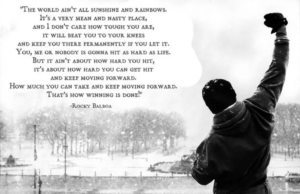
The Idea
Resiliency and Grit are learned behaviors that enable us to not only survive, but thrive in the face of adversity. This is your 8th of 14 daily messages, each containing an exercise designed to strengthen your development of these two key skills. Keep a journal, record your reflections and chronicle your growth.
Exercise #8
Remember the saying, “What you see is what you get?” Well it’s not any different when we consider our focus on life. The manner in which we orient our thoughts can influence our experiences, for better or for worse. Once again, it’s a choice, but to be clear, there are numerous studies demonstrating that a positive attitude serves to foster subsequent affective experiences and outcomes. In other words, we find what we seek!
The goal of this exercise is to notice the difference between a positive and negative outlook and develop an awareness of your own power to look at situations from a certain perspective.
Let’s begin with a sense of reality! It is important to note that positive thinking is not always beneficial, especially when it is used to avoid or control negative experiences; this is a form of experiential avoidance. Pessimism serves a purpose, as it actually helps us to maintain caution, prudence, and analytic thinking (which are key components to effective decision-making). The goal is not to become only optimistic and never pessimistic; it is about choosing which will be most effective for a given situation. Let’s begin
Imagine that there are two chairs situated directly in front of the one you are seated in now. One is labeled “Pessimist”, the other “Optimist”. Bring your journal and take a seat in the Pessimist chair and answer the following questions from your inner pessimist; the one with the bleak, negative outlook on life: Over the past week…
- What negative or unpleasant emotions showed up?
- What were some things that annoyed you
- What difficulties did you face at work?
- What was challenging at home?
- What is one thing that made you disappointed in yourself?
Now, move into the Optimistic mindset chair, however this time you will respond from your inner optimist. The inner optimist views events in life as less personal, permanent and pervasive. In other words, our inner optimist recognizes that events and situations in life involve other people and other circumstances, are temporary, and are unique and specific experiences. Over the past week:
- What pleasant emotions showed up?
- What were some things that made you feel happy, excited, or joyful?
- What good things happened at work?
- What was worked well at home?
- What is one thing that made you proud of yourself?
Now, come back and take a seat in your normal chair. Consider the following:
- How did it feel to embody your pessimistic mindset? What did you notice?
- How did it feel to embody your optimistic mindset?
- What did you learn from this exercise?
- How could you use your insights from this exercise in your daily life?
Some people like to select a frame after they have created the picture. Why not pre-select a frame into which your picture will fit. My choice is to frame my world from a positive perspective. What’s yours?
